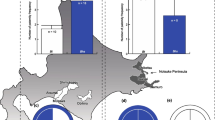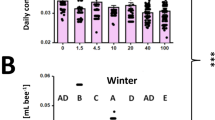Abstract
The feasibility of using the synthetic sex pheromone, disparlure, as a mating confusant of the nun moth (Lymantria monacha L.) was investigated on wild populations occurring in outbreak proportions in Poland and in low density in Czechoslovakia. The size of experimental plots ranged from 1 to 12 hectares. The amounts of pheromone applied were 10 or 20 g/hectare. Three types of slow-release formulations of a racemic mixture of disparlure were tested: (1) a spray formulation with latex as a carrier, (2) a tubing of natural rubber, and (3) sawdust of a porous material used for making tips of fiber-tip pens. All three pheromone formulations prevented significant numbers (98.6–100% in the low density situation, 90–96.2% during the outbreak) of the males from locating a discrete source of pheromone (a trap containing synthetic pheromone or a female) during the whole flight period, indicating long-lasting efficiency of the formulations.
Similar content being viewed by others
References
Altenkirch, W. 1985a. Versuche zur biologischen Bekämpfung der Nonne mit Hilfe der Konfusions-Technik.Forstwirtsch. Holzwirtsch. 40:102–104.
Altenkirch, W. 1985b. Überwachung der Nonne in Niedersachsen.Forst Holzwirt. 40:368.
Altenkirch, W. 1986. Die Nonne (Lymantria monacha L.) in Nordwestdeutschland 1977–1980.Am. Schaedlingskd. Pflanz. Umweltschutz 59:67–74.
Apel, K.H., Häussler, D., andWawrzyniak, H. 1984. Ratio-nalisierungsmöglichkeiten bei der Überwachung der Nonne (Lymantria monacha L.) durch Pheromonanwendung.Soz. Forstw. 34:314–316.
Beroza, M., andKnipling, E.F. 1972. Gypsy moth control with the sex attractant pheromone.Science 177:19.
Bierl, B.A., Beroza, M., andCollier, C.W. 1970. Potent sex attractant of the gypsy moth: Its isolation, identification, and synthesis.Science 170:87–89.
Bierl, B.A., Beroza, M., Adler, V.E., Kasang, G., Schröter, H., andSchneider, D. 1975. The presence of disparlure, the sex pheromone of the gypsy moth, in the female nun moth.Z. Naturfosch. 30c:672–675.
Boness, M., Schulze, W., andSkatulla, U. 1974. Versuche zur Bekämpfung der Nonne,Lymantria monacha L. mit dem synthetischen Pheromon Disparlure.Anz. Schaedlingskd. Pflanz. Umweltschutz 47, 119–122.
Doane, C.C., andMcManus, M.L. 1981. The Gypsy Moth: Research toward Integrated Pest Management. Technical Bulletin 1584. USDA, Washington, DC, p. 757.
Jensen, T.S., andNielsen, B.O. 1984. Evaluation of pheromone catches of the nun moth,Lymantria monacha L.Z. Angew. Entomol. 98:399–413.
Maksymov, J.K. 1978. Überwachung der Nonne,Lymantria monacha L. (Lepidoptera, Lymantriidae) in den Walliser Alpen mit Hilfe von Disparlure.Anz. Schaedlingskd. Pflanz. Umweltschutz 51:70–75.
Pfeffer, A. 1954. Forest Zoology II. Státní zemedelské nakladatelství, Praha, pp. 622 (in Czechoslovakia).
Plimmer, J.R. 1982. Disruption of mating in the gypsy moth, pp. 135–154,in A.F. Kydonieus and M. Beroza (eds.). Insect Suppression with Controlled Release Pheromone Systems II. CRC Press, Boca Raton.
Schmutzenhofer, H. 1986. Zur Überwachung und Desorientierung des Forstschädlings Nonne,Lymantria monacha L., mit dem Sexuallockstoff Disparlure.Anz. Schaedlingskd. Pflanz. Umweltschutz 59:125–130.
Schönherr, J. 1972. Die Wirkung von Disparlure auf die Nonne.Z. Angew. Entomol. 71:260–263.
Schwalbe, C.P., Prascek, E.C., Bierl-Leonhardt, B.A., andPlimmer, J.R. 1983. Disruption of gypsy moth (Lepidoptera, Lymantriidae) mating with disparlure.J. Econ. Entomol. 76:841–844.
Skuhravý, V., Capek, M., andHochmut, R. 1974. Verwendung vonLymantria dispar-Pheromon zur Kontrolle des Vorkommens under der Flugdauer vonLymantria monacha L. undLymantria dispar L.Anz. Schaedlingskd. Pflanz. Umweltschutz 47:59–62.
Śliwa, E., andSierpiński, Z. 1986. Gradation der Nonne (Lymantria monacha L.) in Polen von 1978 bis 1984.Am. Schaedlingskd. Pflanz. Umweltschutz 59:81–86.
Vrkoc, J.,Kalvoda, L.Skuhravý, V.,Hochmut, R., andZdárek, J. 1981 Experiments on communication disruption with pheromones inZeiraphera diniana Gn. andLymantria monacha L. in Czechoslovakia, pp. 130–133,in A. Skirkevicius (ed.). Insect Chemoreception, No. 6, Vilnius (in Russian).
Author information
Authors and Affiliations
Rights and permissions
About this article
Cite this article
Žďárek, J., Vrkoč, J., Hochmut, R. et al. Male confusion of the nun moth with disparlure at high and low population densities. J Chem Ecol 14, 537–547 (1988). https://doi.org/10.1007/BF01013905
Received:
Accepted:
Issue Date:
DOI: https://doi.org/10.1007/BF01013905




